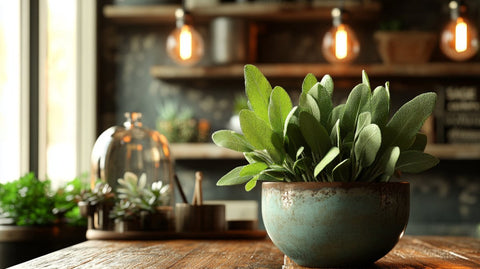Introduction
The sago palm, with its striking, feathery green foliage and sturdy trunk, has long been a favorite among plant enthusiasts and landscapers alike. This prehistoric beauty, often perceived as a palm but actually a cycad, brings a touch of the tropics to homes and gardens across the world. Despite its elegance, the sago palm's growing history dates back millions of years, echoing its resilience and adaptability. By exploring this comprehensive guide, you'll gain the expertise needed to keep your sago palm thriving, whether you're a seasoned gardener or a budding plant parent.
Understanding the Sago Palm

A. Botanical Background
While commonly referred to as a palm, the sago palm (Cycas revoluta) is part of the cycad family, distinguished by its hard, woody trunk and crown of glossy evergreen leaves. Cycas revoluta belongs to the division Cycadophyta, an ancient lineage that predates even dinosaurs. Native to the subtropical regions of southern Japan, including areas like Kyushu and the Ryukyu Islands, the sago palm thrives in well-drained soils and bright sunlight.
B. Characteristics and Cycle
The sago palm is known for its slow growth and long life, which can span over a century under the right conditions. As a dioecious plant, sago palms have distinct male and female plants, each producing different types of cones. The characteristic dark-green, pinnate leaves can grow up to five feet long, arching gracefully from the crown, giving the plant an exotically lush appearance. Its slow growth makes it a perfect candidate for indoor displays and patio gardens.
Ideal Growing Conditions for Sago Palms
A. Light Requirements
Sago palms adore light, thriving best in bright, indirect sunlight. If you're growing your sago palm indoors, placing it near an east or west-facing window will provide ample light exposure. However, direct afternoon sun should be avoided as it can scorch the leaves. In outdoor settings, sago palms will flourish in partial shade environments.
B. Soil and Potting
Healthy sago palms require a well-draining soil mix, rich in organic matter. A combination of sandy soil and peat moss works excellently to mimic their natural habitat. When potting, ensure you choose a container with sufficient drainage holes to prevent water logging. Elevating the pot slightly can also improve drainage and air circulation around the roots, encouraging healthy growth.
C. Watering Needs
While sago palms are drought-tolerant, they do best when their soil is kept moderately moist. Allow the top inch of soil to dry out between waterings to prevent root rot. In cooler months, reduce watering frequency as the plant's growth slows down significantly during this period. Always ensure the potting mix is well-drained to avoid water-heavy soil around the roots.

Common Care Practices for Sago Palms
A. Fertilization
Fertilizing your sago palm is key to maintaining its vibrant green foliage and encouraging new growth. Use a balanced, slow-release fertilizer twice a year during the growing season, once in the early spring and again in late summer. Too much fertilizer can be detrimental, leading to salt buildup and nutrient burn, so follow the recommended package instructions carefully.
B. Pruning and Maintenance
Regular maintenance of your sago palm involves pruning brown or damaged fronds to promote tidiness and encourage healthy growth. Prune only the lower, older leaves as needed, using sharp, sterilized tools to prevent disease spread. Avoid excessive pruning, which can stress the plant. Removing only what is necessary helps maintain the palm's natural form and robust health.
C. Pest and Disease Management
Sago palms, like many houseplants, are susceptible to pests such as scale, mealybugs, and spider mites. Regularly inspecting your plant and applying horticultural oil or insecticidal soap can help control infestations. Additionally, ensuring good air circulation and proper watering practices can reduce the risk of fungal diseases like root rot.
Seasonal Care Tips for Sago Palms
A. Spring and Summer Care
During spring and summer, sago palms enter their active growing phase. This is the best time to fertilize and repot if necessary. Ensure consistent watering, allowing the soil to dry slightly between sessions. Increase humidity levels if needed by misting the leaves or using a pebble tray.
B. Autumn and Winter Care
As growth slows during cooler months, reduce watering to prevent excessive moisture and potential root rot. Keep your sago plant in a warm area, as these plants do not tolerate heavy frost. If necessary, provide protection for outdoor palms during unexpected cold snaps.

Benefits of Having a Sago Palm in Your Home
A. Aesthetic Appeal
The sago palm offers a lush, tropical aesthetic that easily enhances indoor decor or garden landscapes. Its symmetrical shape and dense foliage make it an eye-catching centerpiece or an elegant addition to existing plant groups.
B. Air Quality Improvement
Like many indoor plants, sago palms can contribute to air purification by removing toxins from the air, thus improving the overall quality of the indoor environment. Adding a sago palm to your collection not only beautifies your space but can also promote a healthier living atmosphere.
Common Challenges and Solutions for Sago Palm Care
A. Yellowing Leaves
Yellow leaves can indicate a variety of issues, from improper watering to nutrient deficiencies. Ensure your watering schedule suits the plant's needs and that you're fertilizing regularly to provide essential nutrients. Adjust lighting and temperature to optimal levels to prevent further stress.
B. Browning Tips
If your sago palm develops brown leaf tips, consider environmental factors such as humidity and water quality. Ensure you're using non-saline water and increasing humidity levels if necessary, especially in dry indoor climates.

Propagating Sago Palms
A. Propagation Techniques
Sago palms are best propagated through offsets or “pups” that grow at the base of the parent plant. Wait until these pups are at least 2-3 inches long before separating them for propagation. Using a clean, sharp knife, carefully remove the pup, including its roots, and plant it in a suitable potting mix.
B. Care for Young Sago Palms
Once potted, young sago palms require similar care to mature plants, with particular attention to humidity and light levels. Make sure they are not overwatered as their smaller root systems are more susceptible to rot. Gradually adjust light exposure as they settle into their new growing environment.
Transform Your Space with Sago Palms from Plantology
Now that you’re equipped with the essential knowledge to care for sago palms, why not explore how they can elevate your living space? At Plantology, we offer a range of beautiful plants to complement your sago palm, such as the elegant Adonidia Palm, perfect for any tropical-themed setup.
Visit Plantology's website today for more options and expert advice on plant care. Transform your home into a lush oasis with our curated selections.
Conclusion
Owning a sago palm is more than adding a plant to your home; it’s about embracing a piece of history and elegance that connects you with nature’s past. With their timeless beauty and relatively undemanding upkeep, sago palms are a rewarding choice for enhancing any indoor or outdoor space. Follow this guide to ensure your palm thrives and flourishes, bringing a touch of tropical allure to your surroundings.
Exploring the Rich History of Sago Palms

The sago palm, scientifically known as Cycas revoluta, is often underestimated due to its seemingly simple yet majestic appearance. Its history is as rich and intricate as the plant itself, dating back to prehistoric times. This section delves into the fascinating journey of the sago palm, tracing its evolution and cultural significance over millennia.
The Dawn of Cycads
Cycads are among the oldest plant groups on earth, with fossil records dating back over 280 million years to the late Paleozoic era. These ancient plants witnessed the rise and fall of dinosaurs, thriving through climatic shifts that shaped the planet. Cycads, including the beloved sago palm, have displayed incredible resilience and adaptability, traits that have allowed them to persist through ages of environmental evolution.
Cultural Significance Across Regions
The sago palm holds various cultural significances around the world, especially in its native regions. In ancient Japan, the palm symbolized protection and was often planted near homes to ward off evil spirits. The plant's resilience and longevity are reflective of the cultural values of endurance and steadfastness found in numerous East Asian traditions.
Beyond Asia, sago palms were embraced by European and American horticulturists in the 18th and 19th centuries as an essential component of exotic gardens and botanical collections. Their distinct appearance blended seamlessly with the Victorian era's fascination with far-off lands and plants of unusual form. Today, sago palms continue to captivate plant enthusiasts and decorators alike, cherished for their timeless charm and minimalistic elegance.
Integrating Sago Palms into Landscape Designs
Incorporating sago palms into garden and landscape designs can elevate the aesthetic appeal and introduce a sense of tranquility. Their versatile nature allows them to fit various design concepts, from tropical havens to modern minimalist gardens. This section explores different landscaping ideas and care tips for outdoors sago palm growth.
Xeriscaping with Sago Palms
Sago palms are an excellent choice for xeriscaping, a landscaping technique that reduces the need for irrigation and maintenance. Their drought tolerance and hardy structure make them perfect for dry gardens. Pairing sago palms with succulents, rock gardens, or desert-native plants creates a visually stunning and sustainable landscape. Consider the layout and spacing, allowing enough room for each plant to thrive without competing for resources.
Sago Palms in Tropical-Themed Gardens
For those dreaming of a lush, tropical escape, sago palms serve as the quintessential centerpiece. Surround your palms with other tropical plants such as ferns, banana plants, or bird of paradise for an immersive experience. Incorporate elements like water features or stone pathways to create a resort-like atmosphere right in your backyard. Be mindful of layering—position taller species behind sago palms to construct depth and interest.

Advanced Care Techniques for Enthusiasts
As you become more comfortable with sago palm care basics, elevating your skills with advanced techniques can maximize your plant's health and aesthetic appeal. This section outlines specialized practices and troubleshooting strategies that cater to experienced plant enthusiasts.
Soil Amendment for Optimal Growth
While a general well-draining potting mix is sufficient for most sago palms, enhancing the soil with additional amendments can promote vigorous growth and resilience. Consider incorporating pumice or perlite to further improve drainage. Organic compost or aged manure can be added to enrich the soil with nutrients, supporting robust leaf and trunk development. Remember that balance is key—too much organic matter can impede drainage, counteracting the benefits.
Addressing Common Nutritional Deficiencies
Sago palms, despite being hardy, can sometimes show signs of nutritional deficiencies. Yellowing younger leaves might indicate a manganese deficiency, a condition treatable with manganese sulfate supplements. If interveinal yellowing appears, iron deficiency might be the culprit. In such cases, applications of a chelated iron supplement can correct the imbalance. Regular monitoring and soil testing can preemptively address these issues, ensuring your palm remains healthy.
Common Myths About Sago Palms
Over time, various myths and misconceptions about sago palms have surfaced, often deterring potential owners or spreading misinformation about their care. Let's debunk some of the most prevalent myths:
Myth: Sago Palms are True Palms
Despite their name, sago palms are not true palms but cycads, as previously discussed. This misunderstanding can lead to improper care techniques better suited for actual palm species. Understanding their unique classification is crucial for their proper care and maintenance.
Myth: Sago Palms are Low-Light Tolerant
While sago palms can survive in lower light conditions, they thrive best in bright, indirect sunlight. A prolonged lack of light can hinder growth and lead to overly elongated stems or pale foliage. It's essential to provide adequate lighting to ensure vitality and prevent unnecessary stress on the plant.
Myth: Frequent Watering is Beneficial
Contrary to common belief, frequent watering can be detrimental to sago palms, which prefer their soil to dry out between watering sessions. Overwatering can lead to root rot, a common but severe issue that can stunt growth or even kill the plant. Emphasizing proper watering practices and acclimatizing to seasonal shifts in moisture requirements is key to maintaining healthy sago palms.

Environmental Impact and Conservation Efforts
As ancient lifeforms with significant ecological roles, cycads, including sago palms, face unique environmental pressures. This section highlights the conservation efforts needed to protect these venerable plants and why their preservation is vital.
Threats to Sago Palms in the Wild
Like many plant species, sago palms are threatened by habitat loss, over-collection, and climate change. Deforestation and land development in their native habitats reduce available land for natural growth and reproduction. Additionally, the demand for ornamental cycads places pressure on wild populations, often resulting in unsustainable harvesting practices.
Conservation Initiatives
Various organizations worldwide are committed to protecting cycads through conservation programs and research. These efforts include cultivating cycads in botanical gardens for study and propagation, reintroducing individuals to their natural habitats, and promoting sustainable landscaping practices that protect native plant populations. Supporting these initiatives and choosing sustainably sourced plants can contribute to the preservation of these ancient species.
Endnote: Creating a Lasting Connection with Nature
By bringing a sago palm into your home, you do more than enhance your aesthetic space; you form a living connection to nature's ancient past. As you nurture your sago palm, consider the remarkable journey that has led this plant to grace your home. Through understanding, patience, and intentional care, you can witness the graceful resilience of a species that has shared the Earth with us for ages.
For those inspired to deepen their connection with plant life, exploring the world of cycads offers endless opportunities to learn and grow. From their storied history to their future in conservation, sago palms invite us all to participate in a global effort to honor and preserve the intricate wonders of the natural world.
Your Journey Begins Here
Whether you're a seasoned gardener or new to plant care, embracing the sago palm as part of your collection can bring unparalleled beauty and a sense of historical wonder to your home. As you venture into crafting your garden oasis, remember the timeless allure of the sago palm and the ancient beauty it embodies.
Thank you for taking the time to explore the profound facets of sago palms. For more guidance, inspiration, and top-quality plants, consider visiting Plantology's extensive collection, where your green journey awaits. Together, let's cultivate beauty and legacy in every leaf.






























Comments (0)
There are no comments for this article. Be the first one to leave a message!